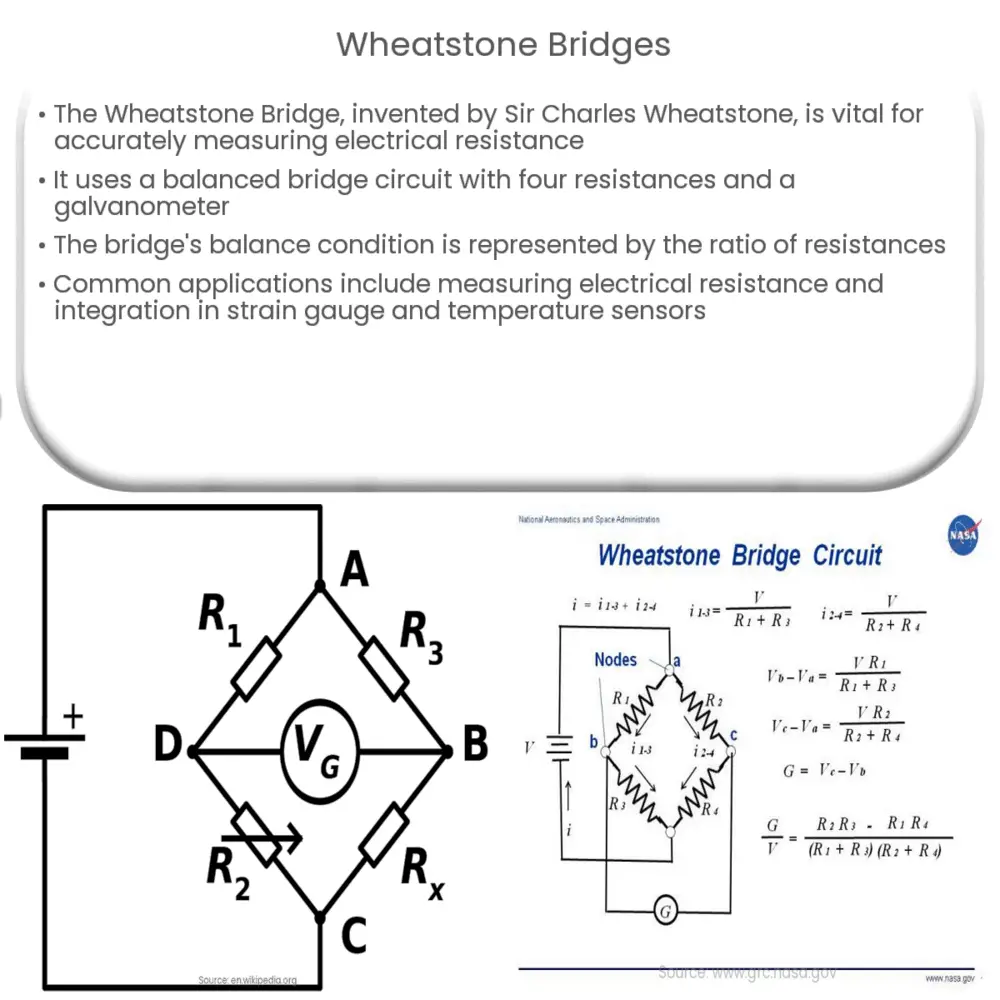Explore the Wheatstone Bridge, its working principle, applications, advantages, and limitations in our comprehensive guide to this essential electrical circuit.

Introduction to Wheatstone Bridges
Wheatstone Bridge, named after its inventor Sir Charles Wheatstone, is a crucial electrical circuit that plays a pivotal role in the accurate measurement of electrical resistance. This simple, yet efficient, device boasts an impressive accuracy level that standard equipment struggles to match. Consequently, it has become indispensable in a broad range of applications, from laboratory experimentation to professional electrical installations.
Working Principle of Wheatstone Bridge
The working principle of the Wheatstone Bridge is rooted in the concept of balanced bridge circuits. The bridge consists of four resistances that form a quadrilateral circuit with a galvanometer (a device that measures small electric currents) and a battery connected between them. The four resistances are divided into two pairs, with each pair having a known and an unknown resistance. The objective is to ascertain the unknown resistance by adjusting the known resistances until the bridge reaches a balanced state.
The Balance Equation
The balance condition of the Wheatstone Bridge is represented by the equation R1/R2 = R3/R4, where R1, R2, R3, and R4 denote the four resistances. The galvanometer comes into play here, displaying zero deflection when the bridge is balanced. This implies that the ratio of the resistances in the first pair equals the ratio in the second pair, effectively allowing the calculation of the unknown resistance.
Applications of Wheatstone Bridge
- Measurement of electrical resistance: The Wheatstone Bridge is most commonly utilized for its ability to measure unknown electrical resistances with high accuracy. It offers a simple, effective, and highly reliable way to assess resistance values.
- Strain gauge sensors: Strain gauges are sensors that measure physical changes such as pressure, force, or strain. Wheatstone Bridge circuits are often incorporated in these devices to convert these changes into measurable electrical signals.
- Temperature sensors: The Wheatstone Bridge is also used in temperature sensors like Resistance Temperature Detectors (RTDs) and thermistors. Here, the bridge circuit facilitates the measurement of temperature by monitoring the resistance changes of the sensor with temperature variations.
Advantages and Limitations of Wheatstone Bridge
The Wheatstone Bridge offers numerous advantages, contributing to its widespread usage. For one, it is highly sensitive and precise, allowing for highly accurate measurements of electrical resistance. Furthermore, it is adaptable, being able to be used in diverse applications, including in the creation of temperature and strain sensors.
Despite these benefits, it is important to note that the Wheatstone Bridge has some limitations. Its accuracy is contingent upon the precision of the known resistances and the sensitivity of the galvanometer. Variations in these factors can result in inaccurate measurements. Additionally, the bridge’s performance may be affected by factors such as temperature fluctuations and the quality of the components used in the circuit.
Modern Variations and Improvements
Over time, several variations of the Wheatstone Bridge have been developed to overcome its limitations and expand its application. For instance, the Kelvin Bridge, an advanced version, has been introduced to measure low resistance values with high accuracy. Additionally, digital bridges employ integrated circuits and digital technology for automatic balancing, improving accuracy and convenience.
Conclusion
In conclusion, the Wheatstone Bridge is a fundamental tool in the electrical engineering world due to its ability to measure unknown resistances with remarkable accuracy. Its simplicity, combined with its precision and versatility, have ensured its continued relevance over the years. Despite some limitations, its various adaptations and improvements have further extended its utility and application. Understanding the working principle and application of the Wheatstone Bridge is thus essential for anyone working in the electrical and electronics field.

